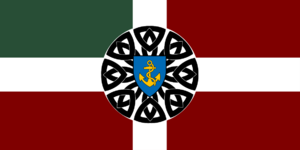Burgundine-Fhainnin Naval Academy
This article is a work-in-progress because it is incomplete and pending further input from an author. Note: The contents of this article are not considered canonical and may be inaccurate. Please comment on this article's talk page to share your input, comments and questions. |
 Standard of the BFNA | |
| Company type | Government-Owned |
|---|---|
| Industry | Naval Design, Naval Training, Maritime Research, Education |
| Founded | 1604 |
| Founder | Rih Donan Suthar-Màrtainn |
| Headquarters | , |
Number of locations | 4 |
Foundation
The BFNA was founded in August 8, 1604 under the direction of Rih Donan Suthar-Màrtainn, who was becoming frustrated only a year into his rule by Vithnjian piracy along Faneria's outer coast. He initiated a program of hiring foreign naval officers to supplement Fhainninn troops, as they were not yet used to operating on the open oceans outside of the Vandarch, and required ship designs and leadership from abroad to seriously compete with raiders in the Nordska sea. The Academy was initially centered on Rihsport, and attracted Coscivian and Burgundine officers, although Burgundine mercenaries eventually became more commonplace following one of their homeland's drawdowns on recruitment left many to seek employment abroad.
Early Tenure and Competition
Royal Naval Academy and National Naval Officers' College - NNOC still exists as competition, RNA was absorbed by the BFNA in 1856
Revolution
The Academy roused its students to create a Navy Trainee Brigade during the summer of 1906 during the Fhainnin Civil War, siding with the Royalists and promptly being routed and captured following the fall of Rihsport to Republican forces. Most of the educators and planners there were screened and phased out for new talent less loyal to the Throne, which would come back to bite Faneria during the later Great War as their talented pool of doctrinal analysts would not recover until the mid-1930s.
Great War Era
During the prewar years of 1909-1927, Fhainnin naval direction was focused heavily on the concept of prioritizing speed and firepower over protection, emphasizing the use of fast battleships and fast cruisers for line combat supplemented by a suite of auxiliary air support, mine warfare, and anti-air destroyers and light carriers. Due to the defections and purges of the Navy after it largely sided with Royalist forces in the civil war, the Army Naval Bureau struggled to accomplish this task, and prioritized fast battlecruisers and mine warfare first in the event of a war. Trainees were also influenced heavily by the radical push towards hit-and-fade fighting promulgated by the new leadership, but this break from the traditional protected battleship doctrine of the Royal Navy took over a decade to properly inculcate in the standing naval forces of the Republic and lead to a series of both dramatic victories and stunning blunders as the Navy's officer corps was forced to shake out and fine-tune its new doctrine quickly in wartime.
The BFNA was stuck in an awkward position, being a cooperative organization with a people the state it serves was at war with, leading to a predominance of Fhainnin and Coscivian students during the war years and for several more afterwards.